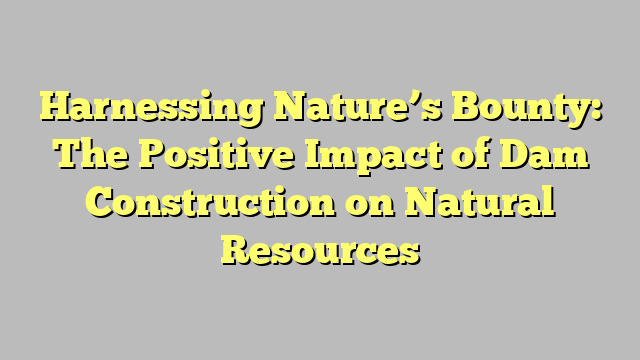Harnessing Nature’s Bounty: The Positive Impact of Dam Construction on Natural Resources
Harnessing Nature’s Bounty: The Positive Impact of Dam Construction on Natural Resources
Dam construction has long been a topic of debate among environmentalists, engineers, and policymakers. While concerns about ecological disruption and displacement of communities are valid, it’s equally important to recognize the positive impacts of dam construction on natural resources. This article explores how dams harness nature’s bounty, contributing to water management, energy production, and agricultural development.
Water Management and Conservation
One of the primary benefits of dam construction is improved water management. Dams play a crucial role in storing, controlling, and distributing water—a resource that’s becoming increasingly scarce in many parts of the world.
Storage and Supply
Dams create reservoirs that store water during rainy seasons, ensuring a steady supply during dry periods. This is particularly important in regions prone to drought, where water scarcity can have severe implications for both human populations and wildlife.
Flood Control
By controlling the flow of water, dams help prevent the devastating effects of flooding. Strategic release of water from reservoirs can mitigate the impact of heavy rains, protecting communities and agricultural lands downstream.
Energy Production
Hydropower, generated by dam construction, is a clean, renewable source of energy that significantly reduces reliance on fossil fuels.
Renewable Energy Source
Hydropower plants convert the kinetic energy of flowing water into electricity. This process doesn’t produce harmful emissions, making it an environmentally friendly alternative to coal and gas power plants.
Meeting Energy Demands
As global energy demands continue to rise, hydropower offers a sustainable solution. Dams provide a reliable and consistent source of energy, capable of adjusting to fluctuations in demand.
Agricultural Development
Dams also play a vital role in supporting agriculture, particularly in arid and semi-arid regions.
Irrigation Support
Water stored in reservoirs can be used for irrigation, transforming barren lands into fertile fields. This not only increases food production but also supports livelihoods and boosts local economies.
Improved Crop Yields
With a reliable water supply, farmers can plan their cropping cycles more effectively, leading to improved yields and the possibility of multiple harvests per year.
Case Studies: Successful Dam Projects
Several dam projects around the world exemplify the positive impact on natural resources and local communities.
| Dam Name | Location | Key Benefits |
|---|---|---|
| Three Gorges Dam | China | Energy production, flood control, navigation improvement |
| Hoover Dam | USA | Water storage, hydroelectric power, flood control |
| Aswan High Dam | Egypt | Irrigation support, hydroelectric power, improved navigation |
Conclusion
While it’s crucial to address the environmental and social challenges associated with dam construction, the benefits cannot be overlooked. Dams offer a multifaceted approach to managing natural resources, providing water for drinking and irrigation, generating clean energy, and protecting against floods. By harnessing nature’s bounty, dams contribute significantly to sustainable development, energy security, and food production. As technology advances, finding ways to minimize the negative impacts while maximizing the positive effects will be key to future dam projects.
Future Perspectives
Looking ahead, the focus should be on innovative design and construction techniques that reduce environmental footprint and enhance the benefits of dams. Collaboration between engineers, environmental scientists, and local communities will be essential in creating sustainable solutions that balance human needs with ecological preservation.

